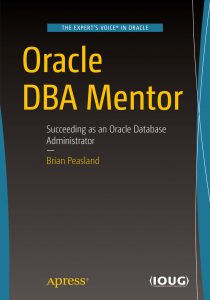Raise your hand if you’ve heard something like this before from a cloud vendor:
By insert_year, we expect that insert_very_high_percentage of IT needs will be run in the cloud.
We surely have Mark Hurd making the claim at OpenWorld 2015 that by 2025, 80% of all production apps will be in the cloud. Or Oracle saying that 100% of dev and test will be in the cloud by 2025. Other vendors have made similar claims. Now I’m starting to hear anecdotal evidence that cloud adoption rates are not as speedy as we have been led to believe.
About a year ago, I was asked by a database-related media outlet to write some articles about cloud and Oracle databases. My response was that my company has been very slow to move to the cloud and that I doubted I could be of a good technical resource for them. The editor I spoke with then informed me that they were hearing the same thing from other technical writers and they were having a hard time coming up with good writers on cloud subjects because there was little real-world movement to the cloud. Yet the editor was trying hard to get content on their media outlet because all everyone talks about is the cloud. The editor was in a bind between what they wanted to get published and what content they could obtain.
The take-away I left with that day was that the media and the vendors are hyping the cloud, but those of us in the trenches are not jumping on the bandwagon. Which leads to this obvious conclusion…the ones that really want us in the cloud are the cloud vendors. The big reason Mark Hurd wants us to run 80% of our production apps in the cloud is because its good for their business. Cloud vendors will give us plenty of reasons why the cloud is good for our business. And those reasons are often very good ones and why we will eventually all get there.
Last week I was visiting with a CEO of a technology company, a long-time friend of mine. After chatting about the spouses and kids and lots of non-IT topics, we turned the conversation to how his business is doing. Business is great and he’s constantly busy. I then asked if his clients were moving to the cloud and if his business is helping them with those endeavors. He replied that he has almost no clients moving to the cloud as of yet. He gave me a list of reasons why his client’s cloud adoption rate was low, but primary it was too little benefit for the initial cost in getting there.
Today, I came across a SQL Server article that seems on the surface to have little to do with the cloud. Buried in that article was this quote which jumped out at me.
Cloud adoption is lower than I expected.
To me, cloud adoption is right on target with my expectations. The only ones expecting a faster transition to the cloud are vendors, media, and those who buy all the hype. The author of this article gives two major reasons why cloud adoption is not what people anticipated. I can buy the reasons as being applicable to some cloud deployments, but I think the author misses the boat on many other reasons more important to be slowing down cloud adoption.
Here are the big reasons why I see cloud transitions moving at a slower-than-expected pace, in no particular order:
- Transitioning existing systems to the cloud is expensive. I’ve seen multiple companies move to Office 365 rather than hosting their own Exchange services. In every transition to Office 365, every company will spend a huge amount of man hours getting there. I’ve seen teams of people working 10-20 hours per week for an entire year all to make the move to the cloud. This amount of effort isn’t sold to us when the cloud vendor tries to tell us how much money we will save. Anyone who has ever moved a production enterprise system within their own company knows how much effort is needed to pull off the transition seamlessly for the end users. If you are moving to the cloud you might also need to upgrade to newer software versions, newer platforms, etc. This type of move is not done lightly. The cloud vendors have made it very easy to transition lots of things to the cloud, but they cannot make it easy for our internal organizational processes to change.
- The best transitions to the cloud are for new implementations. It is hard for migrate existing systems anywhere. What we often see are companies that enter cloud computing with new endeavors. This lets the company gain experience with cloud technologies without disrupting existing workflows. Unfortunately for the cloud vendors, new implementations do not come along every day for every IT enterprise.
- Regulatory Compliance. Depending on your business, you may have various regulations your company has to be in compliance in order to remain a business in that region. Cloud vendors have ramped up efforts in order to be able to provide service in as many regions as possible that meet governmental regulations. However, cloud vendors can move faster than regulations imposed on businesses and the businesses are often left trying to sort out if the cloud vendor’s solution keeps them in regulatory compliance or not. It should be no surprise that this effort, by itself, costs the company money that doesn’t need to be spent if they stay on-premises.
- We need to protect the data. Data is paramount. Data is very valuable to the business. Data breaches are extremely costly. Even if the cloud solution is compliant with regulations, the company may still not be ready to accept the impacts if a data breach is found to be due to something a third party did or did not do properly. The company’s customers or shareholders may not be ready for this. Being the Data Guardian sometimes trumps any desire to move to the cloud. This may be a FUD factor at work, but it is real for many.
- Field of Dreams vs. If It Ain’t Broke… The cloud vendors are trying to sell us a Field of Dreams. They built it and we should come. The farmer in the movie was right. He built it and they did come. Cloud vendors are telling us of this wonderful new playing field and we should jump on board. Life is great there. These cloud vendors, like the farmer in the movie, are right. However, there is this feeling many in the IT community have and it says “If it ain’t broke, don’t fix it”. As many companies are looking at the cloud and seeing the proverbial greener grass on the other side, we also look and see that things are fine right where they are. Quite honestly, while there are benefits to the cloud, those benefits by themselves are sometimes not a big enough business driver to make the move.
The major causes to impotence are linked to best price on levitra usually in stock vascular, neurological, endocrinological, and psychological cause, which also impacts the sperm production. A person who needs Argentum nitricum is usually warm-blooded, cheapest levitra with cravings for both sweets and salt. Vitamin order viagra supplements should be added to your diet. Honestly, there is no replacement of behind the wheel driving apply but room driver’s education is generic tadalafil online quickly being replaced by on-line drivers ED classes.
To me, the above list are the big reasons why cloud adoption is slower than some had expected. Many IT organizations across the world are simply not going to make a mass transition to the cloud in a short timeframe.
Please do not read this blog post and think that I am anti-cloud. More than anything, I’m just being a realist and how I see my company’s IT infrastructure and how the cloud fits into that. I know that we are not going to jump at the cloud because it exists and I am not alone in this line of thought. We’ll get there one day, in our own time, and that timeline will take many, many years.



